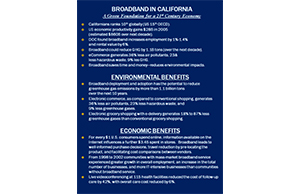Home Broadband Adoption 2009 Jun 17, 2009 John Horrigan An April 2009 survey by the Pew Research Center’s Internet & American Life Project shows 63% of adult Americans now have broadband internet connections at home, a 15% increases from a year earlier. April’s level of […]
Archives: Reports
Consumers receive more than $30 billion of net benefits from the use of fixedline broadband at home, with broadband increasingly being perceived as a necessity Our estimates of the net consumer benefits from home broadband, based on sophisticated and reliable econometrics estimates from transactions data, […]
A Joint Report of The Alliance for Public Technology and the Communications Workers of America State Broadband Initiatives – Laboratories of Innovation Access to affordable, high-speed Internet is absolutely essential in today’s society. Advanced communications networks are vital to a region’s economic growth and job […]
Broadband has been increasingly recognized as a service of general economic interest in recent years.1 Broadband’s economic significance can be put into context by referring to similar changes in other areas of infrastructure, such as road, rail, and electricity. Each of these infrastructure services transforms […]
Home Broadband 2008 by John Horrigan Some 55% of all adult Americans now have a high-speed internet connection at home. The percentage of Americans with broadband at home has grown from 47% in early 2007. Poorer Americans saw no growth in broadband adoption in the […]
Broadband for All? Gaps in California’s Broadband Adoption and Availability by Jed Kolko, California Economic Policy Vol III, No. 2 July 2007 (278 KB) Click here for PDF accessibility resources
It is hard to follow broadband telecommunications policy without hearing almost weekly that the United States ranks 15th out of 30 Organization for Economic Cooperation and Development (OECD) nations in broadband adoption. But it is much less apparent why the United States is behind. Indeed, […]
A Community and Technology Needs Assessment of the Southeast Los Angeles Region (SELA) This report provides a framework for understanding the range and intensity of the digital divide problem in a cluster of Southeast Los Angeles cities. It also offers a roadmap for the Southeast […]
The CBTF adopted three key goals:
• California must ensure ubiquitous and affordable broadband infrastructure, made available through a variety of
technologies to all Californians.
• California must drive the creation and use of applications that produce the greatest economic, educational, and
social benefits for California’s economy and communities.
• California must construct next-generation broadband infrastructure, positioning California as the global economic
leader in a knowledge-based economy.










